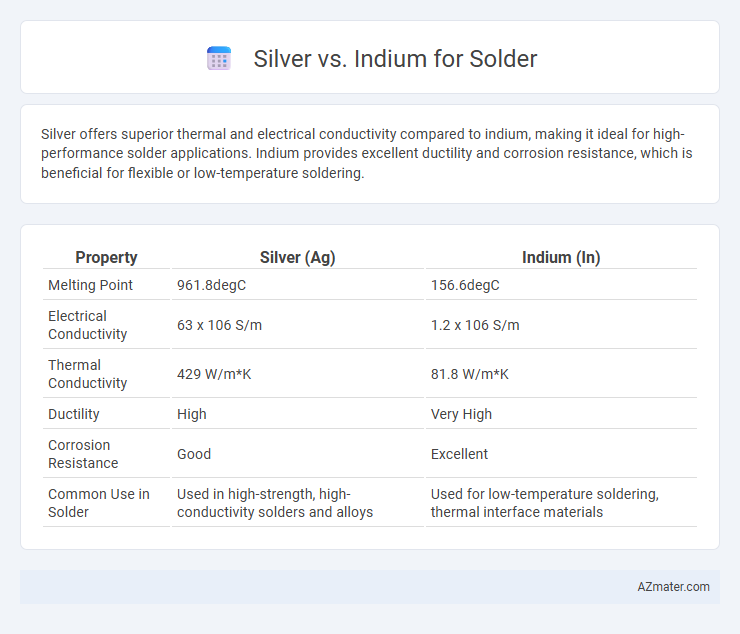Silver offers superior thermal and electrical conductivity compared to indium, making it ideal for high-performance solder applications. Indium provides excellent ductility and corrosion resistance, which is beneficial for flexible or low-temperature soldering.
Table of Comparison
| Property | Silver (Ag) | Indium (In) |
|---|---|---|
| Melting Point | 961.8degC | 156.6degC |
| Electrical Conductivity | 63 x 106 S/m | 1.2 x 106 S/m |
| Thermal Conductivity | 429 W/m*K | 81.8 W/m*K |
| Ductility | High | Very High |
| Corrosion Resistance | Good | Excellent |
| Common Use in Solder | Used in high-strength, high-conductivity solders and alloys | Used for low-temperature soldering, thermal interface materials |
Introduction to Silver and Indium Solder
Silver solder, known for its excellent electrical conductivity and high melting point, is commonly used in electronics for durable and reliable joints. Indium solder offers exceptional corrosion resistance and flexibility, making it ideal for sensitive applications requiring thermal cycling tolerance. Both metals provide distinct advantages in soldering, with silver excelling in strength and indium favored for delicate, low-temperature assemblies.
Physical and Chemical Properties
Silver offers superior thermal conductivity (about 429 W/mK) and excellent electrical conductivity (around 6.3 x 10^7 S/m), making it ideal for high-performance solder applications. Indium provides exceptional malleability and ductility, along with a lower melting point (156.6degC) compared to silver (961.8degC), which reduces thermal stress during soldering. Chemically, silver is more resistant to oxidation and corrosion, while indium is highly reactive, forming stable intermetallic compounds that enhance solder joint strength in specific applications.
Melting Point Comparison
Silver has a melting point of 961.8degC, significantly higher than indium's melting point of 156.6degC, making indium suitable for low-temperature soldering applications. The lower melting temperature of indium reduces thermal stress on components and substrates during the soldering process. Choosing between silver and indium solder depends on the thermal requirements and material compatibility of the specific electronic assembly.
Electrical Conductivity
Silver exhibits a higher electrical conductivity of approximately 63 x 10^6 S/m compared to Indium's significantly lower conductivity near 1.2 x 10^6 S/m, making Silver the preferred choice for solder in high-performance electrical applications. The superior conductivity of Silver solder reduces resistive losses and improves signal integrity, essential in advanced electronics and power delivery systems. Despite Indium's excellent ductility and thermal properties, its lower electrical conductivity limits its use where efficient current flow is critical.
Thermal Conductivity
Silver offers a high thermal conductivity of approximately 429 W/m*K, making it an excellent choice for solder applications requiring efficient heat dissipation. Indium, with a significantly lower thermal conductivity around 81 W/m*K, is less effective in thermal transfer but provides superior ductility and corrosion resistance. For high-performance electronic soldering, silver-based solders are preferred when optimal thermal conduction is critical.
Mechanical Strength and Ductility
Silver-based solder alloys exhibit higher mechanical strength, providing robust joint performance essential for high-stress applications. Indium solder alloys offer superior ductility, allowing for better strain accommodation and improved thermal cycling reliability in flexible or temperature-variable environments. Selecting between silver and indium solders depends on balancing the need for strong mechanical bonds versus enhanced ductile properties for specific electronic or industrial applications.
Corrosion Resistance
Indium solder offers superior corrosion resistance compared to silver-based solder, making it ideal for applications exposed to harsh environments and moisture. Silver solder tends to oxidize and degrade more rapidly when exposed to corrosive elements, which can compromise joint integrity over time. Indium's stable oxide layer provides long-lasting protection against corrosion, enhancing reliability in electronics and aerospace components.
Applications in Electronics
Silver offers excellent electrical conductivity and thermal stability, making it ideal for high-performance electronic soldering in devices requiring robust mechanical strength and corrosion resistance. Indium provides superior flexibility and wetting properties, favored in delicate semiconductor packaging, flexible circuits, and cryogenic electronics due to its low melting point and excellent thermal cycling resistance. The choice between silver and indium solder alloys depends on specific electronic application requirements such as conductivity, mechanical resilience, and operating temperature ranges.
Cost and Availability
Silver offers excellent thermal and electrical conductivity for solder applications but comes with a higher cost due to its market value and limited availability. Indium provides good wetting properties and flexibility, often used in specialized or flexible electronics; however, it is rarer and more expensive than common solder materials, though typically less costly than silver. The availability of silver is more stable due to its broader industrial demand, while indium's supply is constrained by limited mining sources and high demand in display technologies.
Environmental and Health Considerations
Silver solder contains less toxic elements compared to indium solder, which can release harmful indium compounds during soldering, posing respiratory risks. Indium mining and refining have a higher environmental impact due to limited availability and energy-intensive extraction processes, whereas silver is more commonly recycled, reducing ecological footprint. Both metals require careful handling, but silver is generally considered safer for health and more sustainable environmentally in solder applications.

Infographic: Silver vs Indium for Solder
 azmater.com
azmater.com